How Do LED Grow Lights Affect Pollinator Bees
Pollinator bees play a crucial role in ecosystem, pollinating plants that produce fruits, vegetables, and nuts that make up a significant portion of our diet. They are responsible for pollinating about one-third of the world’s food crops. But did you know that their populations around the world have been in decline due to factors like habitat loss, pesticide use, climate change, and disease? If you care about the environment and food security, you might be wondering how you can help these amazing creatures. Well, there is a possible, simple, and effective solution that you might not have thought of: LED grow lights.
How can LED grow lights affect pollinator bees? And how can you use them properly and safely?
In this blog, we will answer these questions and more. If you are interested in learning more about how LED grow lights can affect pollinator bees, then keep reading.
LED grow light can attract pollinator bees
LED grow lights are a popular and effective lighting option for greenhouses and indoor farms, but did you know that they can also attract pollinator bees?
One of the ways that LED grow lights can attract bees is through their customizable spectrum. Bees see light differently from humans - they can perceive ultraviolet wavelengths and are particularly sensitive to blue and green light. This is why they are adept at finding flowers, which reflect UV light as guides to pollen and nectar. LED grow lights can be used to increase the activity and foraging behavior of bees. LED grow lights with moderate blue and UV light output are the most effective at attracting bumblebees, leading to increased forging activity and higher reproductive success during low-daylight conditions. Conversely, LEDs weighted heavily in the blue spectrum or with excessive ultraviolet components can overstimulate and confuse bee navigation and foraging. This light pollution can cause a decrease in the bee population.

Another reason that LED grow lights can attract pollinator bees is that they are beneficial for your plants. LED grow lights can emit different wavelengths of light that can influence the color, shape, and scent of the flowers, making them more appealing and visible to bees. With the right design and strategy, LED grow lights can also promote flowering. In turn, they can attract bees.
Benefits of using LED grow lights for pollinator bees
While excessive or improper use of LEDs can disrupt bees, responsible deployment of LED grow lights aligned with pollinator needs provides multiple benefits. Studies have shown supplemental lighting can extend foraging time and energize populations. Since LEDs are energy-efficient, LED grow lights can save energy costs compared to other light sources.
Increase foraging activity
As mentioned earlier, LED grow lights can be used to attract bees and increase their foraging activity. LED grow lights emit shortwave blue or ultraviolet light and assist bees in navigating to food sources and recognizing flowers.
Another reason that LED grow lights can increase foraging activity is because they can produce light with a high degree of polarization, which is the direction of the electric field of the light waves. Bees can sense the polarization of light and use it to navigate and orient themselves in relation to the sun. This provides a stable reference point for bees to follow, especially on cloudy or foggy days.
By improving the vision and navigation of bees, you can enhance their ability to find and pollinate plants.
Energize populations
In terms of the development of bees, broods require warm and stable conditions. Research indicates infrared and certain visible LED wavelengths can help maintain ideal hive temperatures and simulate natural light cycles for developing larvae.
Additionally, providing light access to hives during the winter or in cold climates can keep colonies active. Breaking dormancy extends productive foraging periods. And active colonies demonstrate improved immunity and communication.
Therefore, LED grow lights can energize populations, support brood development, and generally create an illuminated habitat aligned with bees biological needs.

Energy-efficient & cost-effective
Using LED grow lights to attract pollinator bees is energy-efficient and cost-effective. While LED grow lights may have a higher upfront cost, they tend to last longer and require less maintenance than traditional lighting options. This means you can save money in the long run by using LED grow lights. Moreover, they are much more energy-efficient than conventional light sources. You can provide sufficient lighting for your plants without using as much energy. This is not only good for your wallet but also for the environment.
Best plants to grow under LED grow lights and bees
When deploying LED grow lights to attract and support bees, carefully selecting which plants to cultivate under the supplemental lighting is key. Bees prefer flowers, which they gravitate towards as food sources. Choosing varieties that provide ample nectar and pollen will increase foraging activity once bees discover the LED-lit bounty.
Herbs like lavender, thyme, basil, and mint are very attractive to bees with their aromatic blossoms. These plants thrive under full-spectrum LEDs that energize growth and essential oil production. Other herbs like borage, chives, and oregano also entice pollinators.
Fruiting plants that require pollination, like strawberries, raspberries, citrus trees, and tomato vines, will flourish under LEDs. The extra light fuels fruit production, while the flowers draw in visiting bees. Sunflowers, marigolds, and other ornamental flowers give bees ultraviolet “landing strips” and great pollen rewards.
By incorporating these plants into your greenhouses or indoor farms, you can create an ideal environment for bees to thrive. With the right combination of LED grow lights and bee-friendly plants, you can help support pollinator bee populations and contribute to their conservation efforts.

Tips for creasing a bee-friendly grow room with LED grow lights
Creating a bee-friendly grow room with LED grow lights is a great way to support pollinator bees and contribute to their conservation efforts. Here are some tips for creating a bee-friendly grow room with LED grow lights:
Choose the right kind of plants
Not all plants are attractive or beneficial for bees. You should look for plants that provide nectar and pollen, which are the main food sources for bees. Nectar provides energy, while pollen provides protein and other nutrients. Plants that grow well with LED grow lights to attract and support bees were mentioned earlier.
Use LED grow lights with right spectrum and schedule
Different wavelengths of light can influence the color, shape, and scent of the flowers, making them more appealing and visible to bees. Bees are attracted to blue, purple, and yellow flowers, and they can also see ultraviolet light that humans cannot. LED grow lights that can produce light in the UV spectrum can enhance the patterns and nectar guides on some flowers. LED grow lights that produce too much red or infrared light should be avoided, as these can deter bees or confuse them with heat signals. Bees active periods are synchronized with daylight hours. LED grow lights that follow natural 24-hour light-dark cycles and seasonal day length changes will not disrupt the circadian rhythms of bees. Warm white light is recommended to support the circadian rhythms of bees.
Provide water and shelter
Bees need water to drink and cool themselves, especially during hot and dry periods. You should provide a shallow water source for them. You can also provide some shelter for bees, such as a bee house, a pile of leaves, or wood. These can offer potential nesting places for bees to lay their eggs and protect them from predators or harsh weather conditions.
Avoid pesticides and other chemicals
Pesticides and other chemicals can be harmful or even fatal for bees and other pollinators. They can also contaminate the nectar and pollen that they collect from the flowers. You should avoid using pesticides or chemicals. Instead, you can use natural or organic methods to control pests and diseases, such as companion planting and beneficial insects.
As we've explored, LED grow lights can definitely impact local pollinator bees, in both positive and negative ways, depending on usage. With careful implementation based on research about bee biology and vision, LEDs can provide supplemental illumination that energizes and supports pollinator populations.
At Atop, we provide customized horticulture lighting solutions to meet your specific needs. The tailored spectra and timed cycles of these LED grow lights create an indoor habitat that benefits bee populations and enhances overall biodiversity. Need custom LED grow lights? Please feel free to contact us.

